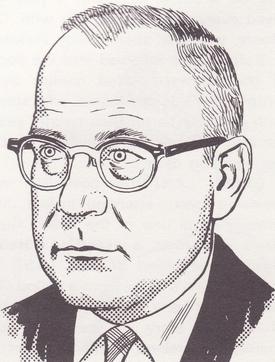
Gardner Francis Cooper Fox was an American writer known best for creating numerous comic book characters for DC Comics. He is estimated to have written more than 4,000 comics stories, including 1,500 for DC Comics. Fox was also a science fiction author and wrote many novels and short stories.

The Justice Society of America (JSA) is a superhero team appearing in American comic books published by DC Comics. It was conceived by editor Sheldon Mayer and writer Gardner Fox during the Golden Age of Comic Books. It first appeared in All Star Comics #3, making it the first team of superheroes in comic books. Its original members were Doctor Fate, Hourman, the Spectre, Sandman, Atom, the Flash, Green Lantern and Hawkman.

The All-Star Squadron is a DC Comics superhero team that debuted in Justice League of America #193 and was created by Roy Thomas, Rich Buckler and Jerry Ordway. Although the team was introduced in the 1980s, its self-titled series took place in the 1940s, retroactively inserting their narratives into the fictional history of the DC Comics superheroes. The team included many of DC's Golden Age era characters, new characters, and other World War II superheroes that DC did not own during the 1940s but later acquired. The name "All-Star Squadron" was creator Roy Thomas' reference to All Star Comics, the series that introduced the Justice Society of America, the first comic book superhero team.
John Broome, who additionally used the pseudonyms John Osgood and Edgar Ray Meritt, was an American comic book writer for DC Comics. Along with Gil Kane, he co-created the supervillain Sinestro.

Flash Comics is a comics anthology published by All-American Publications and later by National Periodical Publications. The title had 104 issues published from January 1940 to February 1949. Despite the title, the anthology featured the adventures of multiple superheroes in addition to Jay Garrick, the original Flash. Characters introduced in the series include the Flash, Hawkman, Hawkgirl and Black Canary.
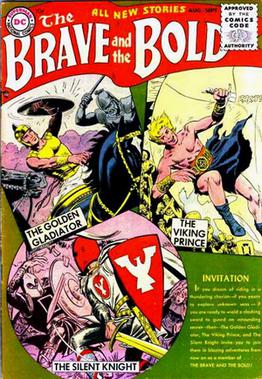
The Brave and the Bold is a comic book series published by DC Comics as an ongoing series from 1955 to 1983. It was followed by a reprint miniseries in 1988, two original miniseries in 1991 and 1999, and was revived as an ongoing anthology title in 2007 and 2023. The focus of the series has varied over time, but it most commonly features team-ups of characters from across the DC Universe.
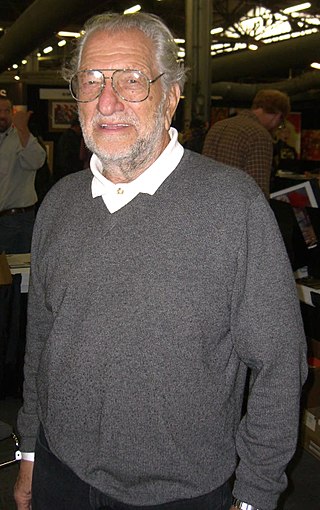
Joseph Kubert was a Polish-born American comic book artist, art teacher, and founder of The Kubert School. He is best known for his work on the DC Comics characters Sgt. Rock and Hawkman. He is also known for working on his own creations, such as Tor, Son of Sinbad, and the Viking Prince, and, with writer Robin Moore, the comic strip Tales of the Green Beret.
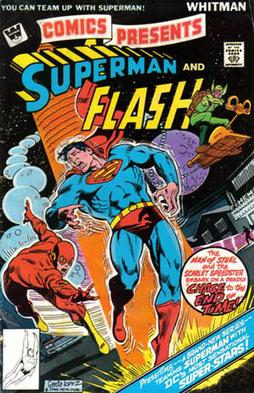
DC Comics Presents is a comic book series published by DC Comics from 1978 to 1986 which ran for 97 issues and four Annuals. It featured team-ups between Superman and a wide variety of other characters in the DC Universe. A recurring back-up feature "Whatever Happened to...?" had stories revealing the status of various minor and little-used characters.

Strange Adventures is a series of American comic books published by DC Comics, the first of which was August–September 1950, according to the cover date, and published continuously until November 1973.
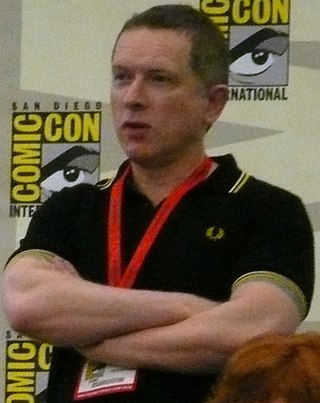
James Dale Robinson is a British writer of American comic books and screenplays best known for co-creating the character of Starman with Tony Harris and reviving the Justice Society of America in the late 1990s. His other notable works include the screenplay for the film adaptation of the Alan Moore and Kevin O'Neill's comic book series The League of Extraordinary Gentlemen and the multi-year crossover storyline "Superman: New Krypton".
Earth-One is a name given to two fictional universes that have appeared in American comic book stories published by DC Comics. The first Earth-One was given its name in Justice League of America #21, after The Flash #123 explained how Golden Age (Earth-Two) versions of characters such as the Flash could appear in stories with their Silver Age counterparts. This Earth-One continuity included the DC Silver Age heroes, including the Justice League of America.
Robert Kanigher was an American comic book writer and editor whose career spanned five decades. He was involved with the Wonder Woman franchise for over twenty years, taking over the scripting from creator William Moulton Marston. In addition, Kanigher spent many years in charge of DC Comics's war titles and created the character Sgt. Rock. Kanigher scripted what is considered the first Silver Age comic book story, "Mystery of the Human Thunderbolt!", which introduced the Barry Allen version of the Flash in Showcase #4.

Mystery in Space is the name of two science fiction American comic book series published by DC Comics, and of a standalone Vertigo anthology released in 2012. The first series ran for 110 issues from 1951 to 1966, with a further seven issues continuing the numbering during an early 1980s revival of the title. An eight-issue limited series began in 2006.
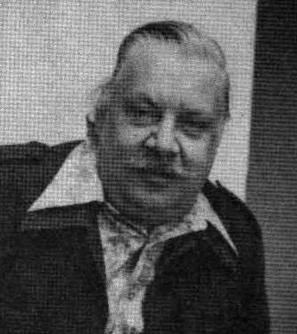
Richard Allen Dillin was an American comics artist best known for a 12-year run as the penciler of the DC Comics superhero-team series Justice League of America. He drew 115 issues from 1968 until his death in 1980.

Sensation Comics is the title of an American comic book anthology series published by DC Comics that ran for 109 issues from 1942 to 1952. For most of its run, the lead feature was Wonder Woman, a character which had been introduced in All Star Comics #8. Other characters that appeared included the Black Pirate, the Gay Ghost, Mister Terrific, Wildcat, Sargon the Sorcerer, Hal Mason, the Whip, the Atom, Little Boy Blue, Hop Harrigan, Romance, Inc., Lady Danger, Doctor Pat, and Astra.

G.I. Combat is an American comics anthology featuring war stories. It was published from 1952 until 1956 by Quality Comics, followed by DC Comics until its final issue in 1987. In 2012 it was briefly revived.

Justice is a twelve-issue American comic book limited series published bimonthly by DC Comics from August 2005 through June 2007, written by Alex Ross and Jim Krueger, with art also by Ross and Doug Braithwaite. Its story involves the superhero team known as the Justice League of America confronting the supervillain team the Legion of Doom after every supervillain is motivated by a shared dream that seems to be a vision of the planet's destruction, which they intend to avoid.

Our Army at War is an American comic book anthology published by DC Comics that featured war-themed stories and featured the first appearances of Sgt. Rock and Enemy Ace. The series was published from August 1952 to February 1977, then was renamed Sgt. Rock in March 1977, continuing the numbering sequence of Our Army at War.
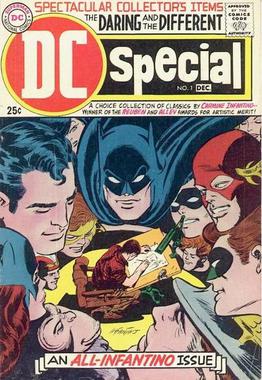
DC Special was a comic book anthology series published by DC Comics originally from 1968 to 1971; it resumed publication from 1975 to 1977. For the most part, DC Special was a theme-based reprint title, mostly focusing on stories from DC's Golden Age; at the end of its run it published a few original stories.
Black Canary is a superheroine appearing in American comic books published by DC Comics. Created by the writer-artist team of Robert Kanigher and Carmine Infantino, the character debuted in Flash Comics #86 as the first Black Canary in the Golden Age of Comic Books. Strong, mysterious, gutsy and romantic, she has been called "the archetype of the new Film Noir era heroine."


















